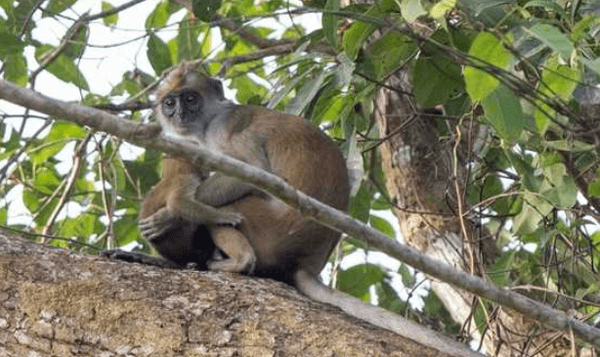Procolobus verus
IUCN
LCBasic Information
Scientific classification
- name:Procolobus verus
- Scientific Name:Procolobus verus,Olive Colobus,Van Beneden's red colobus, pale green colobus
- Outline:Primates
- Family:Cercopithecidae G.colobus
Vital signs
- length:43-50cm
- Weight:3-5.7kg
- lifetime:No verification information
Feature
Olive green fur all over the body
Distribution and Habitat
Olive colobus monkeys are found in Benin, Côte d'Ivoire, Ghana, Guinea, Liberia, Nigeria, Sierra Leone and Togo.
Olive colobus monkeys live in tropical rainforests ranging from lowlands to altitudes of more than 3,000 meters. The forests they live in include rainforests, dry and semi-deciduous forests, palm forests, forest edges, swamp forests and abandoned farmland.
Appearance
The head and body length of the olive green colobus monkey is 43-50 cm; the tail length is 52-80 cm; the male weighs 3.3-5.7 kg, and the female weighs 3-4.5 kg. Like other colobus monkey species, the anal warts are small, the tail is long, and the cheek pouches are smaller than those of ordinary monkeys. They are different from leaf monkeys in that they have no thumbs, although the other fingers are particularly long, and the thumbs have degenerated into a small wart, so they are called colobus monkeys. The whole body is covered with olive green fur, the back is brown, and the lower body chest and abdomen are dark gray. The round head has light gray hair, with a vortex-shaped short gray crest on each side of the forehead, and a dull white beard around the hairless dark face. The fur around the pubic area is white, and the genitals of subadults of both sexes are swollen like those of females, probably to prevent being expelled from the group by mature males when males are immature.
T
Details
Olive Colobus (scientific name: Procolobus verus) is the only colobus in the genus Procolobus.

Olive Colobus is a diurnal species. It is arboreal and moves quickly between trees. They live in small groups of 5-20 individuals, with one adult male, some females and half of the immature young. Multiple males also form groups of monkeys that have not reached breeding age. Group members are very quiet and rarely communicate with loud calls. This is a timid and quiet monkey that can move 10 meters in a single jump through the dense jungle and climb high in the trees to feed its young. When encountering predators such as leopards, the main reaction of the timid green colobus monkey is to move between dense branches and leaves or squat quietly in place with a hunched back.
Olive green colobus monkeys are completely vegetarian, mainly young leaves and flowers, 27% of their diet comes from vines, and they spend a lot of time foraging. They also eat fruits and seeds, the proportion varies according to seasonal quantities, but mature leaves are rarely ingested. They eat food directly with their mouths, rather than grabbing it with their forelimbs and claws.
Olive colobus monkeys do not have a specific breeding season, and the gestation period is 5-6 months. Females become pregnant every two years, usually giving birth to only one pup each time. Females reach sexual maturity at about 3 to 4 years old, and males at about 5 to 6 years old. During estrus, the female's perineum swells. Females carry their pups in their mouths, a behavior not observed in other colobus monkey species. As the pups grow and mature, they cling to their mother's abdomen as she moves. The mother provides milk, grooming, and protection for the pups. The role of males in caring for the pups has not been reported. The species has a maximum lifespan of 30 years.
The main threats to the Olive colobus monkey are due to the loss of its forest habitat and hunting, especially in the eastern part of its range in Africa.
Listed in the IUCN (World Conservation Union) ver3.1: 2008 Red List of Primates - Near Threatened (NT).
Protect wild animals and eliminate game.
Maintaining ecological balance is everyone's responsibility!








